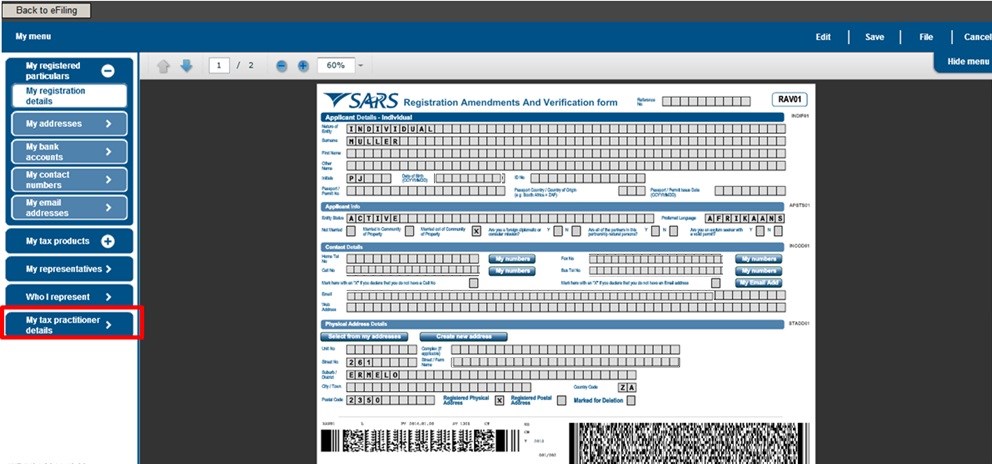Until quite recently, the South African Revenue Service’s online tax filing website required Adobe Flash for all functionality. This aged web plugin allowed SARS to embed editable tax forms in the e-Filing web application. The result looked like this:
Taxes and Flash: a match made in Hell
That’s right, Flash was used to produce a high-fidelty computer simulation of the experience of filling in paper forms with text in block capital letters. Move over, Euro Truck Simulator. Untold hours of development time went into this. Despite standard HTML having supported a wide variety of superior-to-paper form capabilities since the 90s, this happened. And had Flash’s December deprecation not forced a total redesign, this marvel of overengineering would still be with us today.1
I’ve come up with a term for this kind of thing: toxic skeuomorphism. Toxic skeuomorphism happens when you simulate the limitations of physical objects in the digital realm for no good reason.
Flash-based tax forms are the ur-example of toxic skeuomorphism, but this disease expands far beyond them. More subtle examples include Word documents and PDFs. Think about the last Word document you created. Do you ever intend to print it out? If not, then why did you compose it on fake paper? What benefit did the arbitrary size and shape of those fake pages confer on your writing?
A related phenomenon that highly irritates me is the practice of emailing and scanning paper forms. Standard practice for all kinds of businesses, at least where I live, is to email people paper forms so they can print them out, fill them in and sign them, and then email back scanned copies. I always fill them in with GIMP, because I don’t have a printer and my handwriting is atrocious. I have a picture of my signature I paste in where required, rendering the already weak authentication control that is handwritten signatures entirely meaningless.
The alternatives, services like DocuSign, represent a massive improvement over this status quo, but are still wedded to skeuomorphism, showing fake paper forms and fake written signatures. They’re also centralised authorities, and thus not really a robust and accessible solution. A digital-native approach to this problem has to involve cryptography, i.e. actually meaningful signatures that can be verified. Ideally this would be an open standard.
Mouse-drawn signatures aren’t great either.
As a child growing up in the late 90s/2000s, I saw and used representations of paper folders on computer screens before ever coming across the real thing. This must be even more prevalent for younger people. Computers have been the ubiquitous way to deal with information for many decades now, and so it’s way past time we let go of skeuomorphisms designed to transition office workers from physical papers, folders and desktops. To entomb information in dead paper documents is one thing, but to do so using simulated dead paper documents is downright heretical. Ted Nelson laments this in the video I included in my Roam post, reproduced below.
Freed from the arbitrary boundaries of the printed page, we can have text that scales to different display sizes, that can be turned into audio, processed using your favourite programming language, enriched with relevant links, and shared among people in a form that allows editing and commentary, while still always showing the same canonical version to everyone, without the need for manual merges. We have much of this, to varying degrees in the different places, but we cling to paper-sized pages and the idea of the document as an artefact either dead or on its way to death; developed collaboratively up to a point and then mummified as a PDF. And should anyone want to make real use of these mummified documents, they must first conduct an archaeological dig to convert useful information back into its original form.
Of course there are still many uses and reasons for producing completed and immutable read-only text, but that, like digital signatures, is better achieved through cryptography than through pretending that the rules of the physical world still apply. There are even for reasons for producing pages – who doesn’t like a physical print-out, or a beautiful page, every now and then? But this should not be the default form of the document. As pure computer-readable data, documents are alive and infinitely malleable. As printed glyphs on bits of dead tree, they are dead and inert, useful only to humans, and in limited ways.2
In this, the third decade of the 21st century, let us leave behind the paper document. For how can we possibly hope to digitise our brains if we cannot first digitise their transpositions?
-
And, technically speaking, it still is, as of late January 2021. While much of the personal tax filing functionality has been reimplemented in HTML5, there are still many business-facing components that rely on Flash. SARS released a rather ugly Windows-only Electron app with Flash re-enabled as a stop-gap measure. ↩︎
-
This becomes particularly apparent when technical information, such as API references or tabular data, are distributed in PDF form. Forcing this kind of information into paper document form can inflict still further indignities. ↩︎
 David Yates.
David Yates.